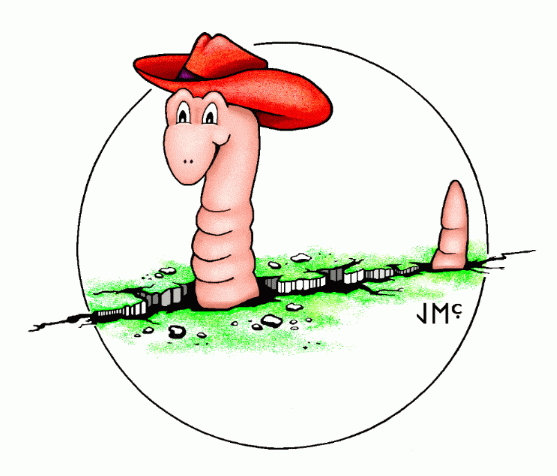But, since all the gardening books and blogs tell me there are in fact good bugs and bad bugs, I have to believe it's true. So, this morning I decided to start cataloging the bugs I run across in my garden to figure out who can stay and who has to go. Some of them are truly disgusting, like those aphids I had to pull off my lettuce plant and squish yesterday. Blech!
This morning, I ran across this guy at the entrance of my garage:
Okay, so this first one is pretty easy. Seems to be an earthworm. I figure he must be okay, because I found this cute cartoon picture of him through Google images:
 |
| Courtesy of this website |
I also solved the mystery of why he was in my garage. According to Wikipedia:
Earthworms can sometimes be found on the surface of the ground following heavy rain storms, as a storm may flood the soil with excessive water. However, if the surface where they find themselves is unexpectedly paved, rocky, or compacted (hardened), they may become stranded, potentially suffering injury or death from causes such as heat, exposure, dehydration, or predation.Well, we have been experiencing several days of heavy rain around here, so maybe this guy got stranded on my driveway and, instead of turning around and going back into the garden, he headed the wrong direction.
Since Wikipedia also tells me that he "play[s] a major role in converting large pieces of organic matter (e.g. dead leaves) into rich humus, and thus improving soil fertility," I picked him up and placed him gently back into the garden where he belongs. And, if you must know, I did not use my bare hands - I used a pen to scootch him into a plastic cup and carried him to the garden in that.
So, that was easy, but I don't think these next guys are quite so benign. They just have a bad look about them.
First, there's this gelatinous looking thing:
 |
| Looks like some sort of slug |
If he is a slug, I have no idea what kind of slug or even if it matters. I figure any slug is probably bad, but I'm not sure. My usual litmus test failed me, because I did in fact find some adorable cartoon pictures of slugs on-line. However, my trusty Vegetable Gardener's Bible tells me that slugs "feed on the soft tissues of a number of vegetables and flowers" and that "[l]ike vampires, they usually work at night or on cloudy days." Aha! I did mention that we've had a lot of rain over the past few days . . . ergo, cloudy days . . . ergo Slugs!
I'm afraid that anyone of a vampiric nature must be eliminated.
They seem to collect around moist, watery areas. Again, I'm sure they can't be good. However, they don't match any of the pictures in my Vegetable Gardener's Bible or my All-New Illustrated Guide to Gardening. I will continue to search on-line and see if I can figure out what they are, but if anyone knows, please tell me!
Update: I think I've figured out what the last guy is. After scouring insect identification websites and running a bunch of searches like "brown scaly bug in damp area of garden" I found with this:
 |
| Say hello to Mr. Woodlouse, courtesy of Bugguide.net |
According to Wikipedia, a Woodlouse is a not an insect, but a "crustacean with a rigid, segmented, long exoskeleton and fourteen jointed limbs." More interesting information about Woodlice from Wikipedia:
Living in a terrestrial environment, woodlice breathe through trachea-like lungs in their paddle-shaped hind legs . . . . Woodlice need moisture because they rapidly lose water by excretion and through their cuticle, and so are usually found in damp, dark places, such as under rocks and logs. . . . They are usually nocturnal and are detritivores, feeding mostly on dead plant matter, although they have been known to feed on cultivated plants, such as ripening strawberries and tender seedlings. Woodlice then recycle the nutrients back into the soil. In artificial environments such as greenhouses where it can be very moist, woodlice may become abundant and damage young plants.
So, that explains why they were congregating in moist, damp areas of my property. I'm also relieved that they are not quite as evil as they look. Interestingly, I did find them close to some rotting leaves and other dead plant matter, so maybe they were just innocently munching on those. On the other hand, they were also quite close to some of my seedlings and young plants, so they may not be entirely without guilt. The circumstantial evidence does not point me toward a clear conclusion.




No comments:
Post a Comment